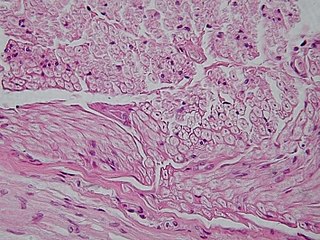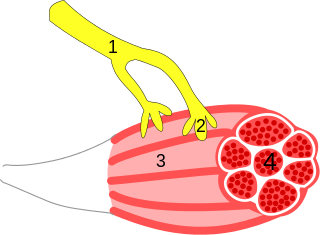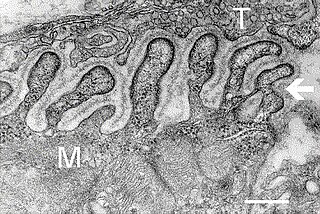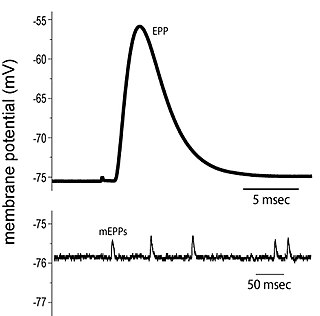Related Research Articles

An axon, or nerve fiber, is a long, slender projection of a nerve cell, or neuron, in vertebrates, that typically conducts electrical impulses known as action potentials away from the nerve cell body. The function of the axon is to transmit information to different neurons, muscles, and glands. In certain sensory neurons, such as those for touch and warmth, the axons are called afferent nerve fibers and the electrical impulse travels along these from the periphery to the cell body and from the cell body to the spinal cord along another branch of the same axon. Axon dysfunction can be the cause of many inherited and acquired neurological disorders that affect both the peripheral and central neurons. Nerve fibers are classed into three types – group A nerve fibers, group B nerve fibers, and group C nerve fibers. Groups A and B are myelinated, and group C are unmyelinated. These groups include both sensory fibers and motor fibers. Another classification groups only the sensory fibers as Type I, Type II, Type III, and Type IV.

A neuron, neurone, or nerve cell is an electrically excitable cell that fires electric signals called action potentials. Neurons communicate with other cells via synapses - specialized connections that commonly use minute amounts of chemical neurotransmitters to pass the electric signal from the presynaptic neuron to the target cell through the synaptic gap. The neuron is the main component of nervous tissue in all animals except sponges and placozoa. Non-animals like plants and fungi do not have nerve cells.

In biology, the nervous system is the highly complex part of an animal that coordinates its actions and sensory information by transmitting signals to and from different parts of its body. The nervous system detects environmental changes that impact the body, then works in tandem with the endocrine system to respond to such events. Nervous tissue first arose in wormlike organisms about 550 to 600 million years ago. In vertebrates it consists of two main parts, the central nervous system (CNS) and the peripheral nervous system (PNS). The CNS consists of the brain and spinal cord. The PNS consists mainly of nerves, which are enclosed bundles of the long fibers or axons, that connect the CNS to every other part of the body. Nerves that transmit signals from the brain are called motor nerves or efferent nerves, while those nerves that transmit information from the body to the CNS are called sensory nerves or afferent. Spinal nerves are mixed nerves that serve both functions. The PNS is divided into three separate subsystems, the somatic, autonomic, and enteric nervous systems. Somatic nerves mediate voluntary movement. The autonomic nervous system is further subdivided into the sympathetic and the parasympathetic nervous systems. The sympathetic nervous system is activated in cases of emergencies to mobilize energy, while the parasympathetic nervous system is activated when organisms are in a relaxed state. The enteric nervous system functions to control the gastrointestinal system. Both autonomic and enteric nervous systems function involuntarily. Nerves that exit from the cranium are called cranial nerves while those exiting from the spinal cord are called spinal nerves.

A motor neuron is a neuron whose cell body is located in the motor cortex, brainstem or the spinal cord, and whose axon (fiber) projects to the spinal cord or outside of the spinal cord to directly or indirectly control effector organs, mainly muscles and glands. There are two types of motor neuron – upper motor neurons and lower motor neurons. Axons from upper motor neurons synapse onto interneurons in the spinal cord and occasionally directly onto lower motor neurons. The axons from the lower motor neurons are efferent nerve fibers that carry signals from the spinal cord to the effectors. Types of lower motor neurons are alpha motor neurons, beta motor neurons, and gamma motor neurons.
The development of the nervous system, or neural development (neurodevelopment), refers to the processes that generate, shape, and reshape the nervous system of animals, from the earliest stages of embryonic development to adulthood. The field of neural development draws on both neuroscience and developmental biology to describe and provide insight into the cellular and molecular mechanisms by which complex nervous systems develop, from nematodes and fruit flies to mammals.

Nervous tissue, also called neural tissue, is the main tissue component of the nervous system. The nervous system regulates and controls body functions and activity. It consists of two parts: the central nervous system (CNS) comprising the brain and spinal cord, and the peripheral nervous system (PNS) comprising the branching peripheral nerves. It is composed of neurons, also known as nerve cells, which receive and transmit impulses, and neuroglia, also known as glial cells or glia, which assist the propagation of the nerve impulse as well as provide nutrients to the neurons.

An excitatory synapse is a synapse in which an action potential in a presynaptic neuron increases the probability of an action potential occurring in a postsynaptic cell. Neurons form networks through which nerve impulses travel, each neuron often making numerous connections with other cells. These electrical signals may be excitatory or inhibitory, and, if the total of excitatory influences exceeds that of the inhibitory influences, the neuron will generate a new action potential at its axon hillock, thus transmitting the information to yet another cell.

A neuroeffector junction is a site where a motor neuron releases a neurotransmitter to affect a target—non-neuronal—cell. This junction functions like a synapse. However, unlike most neurons, somatic efferent motor neurons innervate skeletal muscle, and are always excitatory. Visceral efferent neurons innervate smooth muscle, cardiac muscle, and glands, and have the ability to be either excitatory or inhibitory in function. Neuroeffector junctions are known as neuromuscular junctions when the target cell is a muscle fiber.

A neuromuscular junction is a chemical synapse between a motor neuron and a muscle fiber.

End plate potentials (EPPs) are the voltages which cause depolarization of skeletal muscle fibers caused by neurotransmitters binding to the postsynaptic membrane in the neuromuscular junction. They are called "end plates" because the postsynaptic terminals of muscle fibers have a large, saucer-like appearance. When an action potential reaches the axon terminal of a motor neuron, vesicles carrying neurotransmitters are exocytosed and the contents are released into the neuromuscular junction. These neurotransmitters bind to receptors on the postsynaptic membrane and lead to its depolarization. In the absence of an action potential, acetylcholine vesicles spontaneously leak into the neuromuscular junction and cause very small depolarizations in the postsynaptic membrane. This small response (~0.4mV) is called a miniature end plate potential (MEPP) and is generated by one acetylcholine-containing vesicle. It represents the smallest possible depolarization which can be induced in a muscle.
Molecular neuroscience is a branch of neuroscience that observes concepts in molecular biology applied to the nervous systems of animals. The scope of this subject covers topics such as molecular neuroanatomy, mechanisms of molecular signaling in the nervous system, the effects of genetics and epigenetics on neuronal development, and the molecular basis for neuroplasticity and neurodegenerative diseases. As with molecular biology, molecular neuroscience is a relatively new field that is considerably dynamic.

Alpha (α) motor neurons (also called alpha motoneurons), are large, multipolar lower motor neurons of the brainstem and spinal cord. They innervate extrafusal muscle fibers of skeletal muscle and are directly responsible for initiating their contraction. Alpha motor neurons are distinct from gamma motor neurons, which innervate intrafusal muscle fibers of muscle spindles.

In the nervous system, a synapse is a structure that permits a neuron to pass an electrical or chemical signal to another neuron or to the target effector cell.

Neuroligin (NLGN), a type I membrane protein, is a cell adhesion protein on the postsynaptic membrane that mediates the formation and maintenance of synapses between neurons. Neuroligins act as ligands for β-neurexins, which are cell adhesion proteins located presynaptically. Neuroligin and β-neurexin "shake hands", resulting in the connection between two neurons and the production of a synapse. Neuroligins also affect the properties of neural networks by specifying synaptic functions, and they mediate signalling by recruiting and stabilizing key synaptic components. Neuroligins interact with other postsynaptic proteins to localize neurotransmitter receptors and channels in the postsynaptic density as the cell matures. Additionally, neuroligins are expressed in human peripheral tissues and have been found to play a role in angiogenesis. In humans, alterations in genes encoding neuroligins are implicated in autism and other cognitive disorders. Antibodies in a mother from previous male pregnancies against neuroligin 4 from the Y chromosome increase the probability of homosexuality in male offspring.
Neuromuscular junction disease is a medical condition where the normal conduction through the neuromuscular junction fails to function correctly.

Axon terminals are distal terminations of the telodendria (branches) of an axon. An axon, also called a nerve fiber, is a long, slender projection of a nerve cell, or neuron, that conducts electrical impulses called action potentials away from the neuron's cell body, or soma, in order to transmit those impulses to other neurons, muscle cells or glands.
Cellular neuroscience is a branch of neuroscience concerned with the study of neurons at a cellular level. This includes morphology and physiological properties of single neurons. Several techniques such as intracellular recording, patch-clamp, and voltage-clamp technique, pharmacology, confocal imaging, molecular biology, two photon laser scanning microscopy and Ca2+ imaging have been used to study activity at the cellular level. Cellular neuroscience examines the various types of neurons, the functions of different neurons, the influence of neurons upon each other, and how neurons work together.
Perisynaptic schwann cells are Neuroglia found at the Neuromuscular junction (NMJ) with known functions in synaptic transmission, synaptogenesis, and nerve regeneration. These cells share a common ancestor with both Myelinating and Non-Myelinating Schwann Cells called Neural Crest cells. Perisynaptic Schwann Cells (PSCs) contribute to the tripartite synapse organization in combination with the pre-synaptic nerve and the post-synaptic muscle fiber. PSCs are considered to be the glial component of the Neuromuscular Junction (NMJ) and have a similar functionality to that of Astrocytes in the Central Nervous System. The characteristics of PSCs are based on both external synaptic properties and internal glial properties, where the internal characteristics of PSCs develop based on the associated synapse, for example: the PSCs of a fast-twitch muscle fiber differ from the PSCs of a slow-twitch muscle fiber even when removed from their natural synaptic environment. PSCs of fast-twitch muscle fibers have higher Calcium levels in response to synapse innervation when compared to slow-twitch PSCs. This balance between external and internal influences creates a range of PSCs that are present in the many Neuromuscular Junctions of the Peripheral Nervous System.

Synaptic stabilization is crucial in the developing and adult nervous systems and is considered a result of the late phase of long-term potentiation (LTP). The mechanism involves strengthening and maintaining active synapses through increased expression of cytoskeletal and extracellular matrix elements and postsynaptic scaffold proteins, while pruning less active ones. For example, cell adhesion molecules (CAMs) play a large role in synaptic maintenance and stabilization. Gerald Edelman discovered CAMs and studied their function during development, which showed CAMs are required for cell migration and the formation of the entire nervous system. In the adult nervous system, CAMs play an integral role in synaptic plasticity relating to learning and memory.
An axo-axonic synapse is a type of synapse, formed by one neuron projecting its axon terminals onto another neuron’s axon.
References
- ↑ Huttenlocher, P. R.; Dabholkar, A. S. (1997). "Regional differences in synaptogenesis in human cerebral cortex". The Journal of Comparative Neurology. 387 (2): 167–178. doi:10.1002/(SICI)1096-9861(19971020)387:2<167::AID-CNE1>3.0.CO;2-Z. PMID 9336221.
- ↑ Comery TA, Harris JB, Willems PJ, et al. (May 1997). "Abnormal dendritic spines in fragile X knockout mice: maturation and pruning deficits". Proc. Natl. Acad. Sci. U.S.A. 94 (10): 5401–4. Bibcode:1997PNAS...94.5401C. doi: 10.1073/pnas.94.10.5401 . PMC 24690 . PMID 9144249.
- 1 2 3 4 5 6 7 8 9 10 11 12 13 Sanes JR, Lichtman JW (1999). "Development of the vertebrate neuromuscular junction". Annu. Rev. Neurosci. 22: 389–442. doi: 10.1146/annurev.neuro.22.1.389 . PMID 10202544.
- ↑ Ullian EM, Christopherson KS, Barres BA. 2004. Role for glia in synaptogenesis. Glia 47(3):209-16.
- ↑ Cao G, Ko CP (June 2007). "Schwann cell-derived factors modulate synaptic activities at developing neuromuscular synapses". J. Neurosci. 27 (25): 6712–22. doi: 10.1523/JNEUROSCI.1329-07.2007 . PMC 6672697 . PMID 17581958.
- 1 2 Ethell IM, Ethell DW (October 2007). "Matrix metalloproteinases in brain development and remodeling: synaptic functions and targets". J. Neurosci. Res. 85 (13): 2813–23. doi:10.1002/jnr.21273. PMID 17387691. S2CID 23908017.
- ↑ Hippenmeyer S, Huber RM, Ladle DR, Murphy K, Arber S (September 2007). "ETS transcription factor Erm controls subsynaptic gene expression in skeletal muscles". Neuron. 55 (5): 726–40. doi: 10.1016/j.neuron.2007.07.028 . PMID 17785180.
- ↑ Ghiani CA, Beltran-Parrazal L, Sforza DM, et al. (February 2007). "Genetic program of neuronal differentiation and growth induced by specific activation of NMDA receptors". Neurochem. Res. 32 (2): 363–76. doi:10.1007/s11064-006-9213-9. PMID 17191130. S2CID 18350926.
- ↑ Jelks KB, Wylie R, Floyd CL, McAllister AK, Wise P (June 2007). "Estradiol targets synaptic proteins to induce glutamatergic synapse formation in cultured hippocampal neurons: critical role of estrogen receptor-alpha". J. Neurosci. 27 (26): 6903–13. doi: 10.1523/JNEUROSCI.0909-07.2007 . PMC 6672227 . PMID 17596438.
- ↑ Suzuki S, Kiyosue K, Hazama S, et al. (June 2007). "Brain-derived neurotrophic factor regulates cholesterol metabolism for synapse development". J. Neurosci. 27 (24): 6417–27. doi: 10.1523/JNEUROSCI.0690-07.2007 . PMC 6672445 . PMID 17567802.
- ↑ Zeng X, Sun M, Liu L, Chen F, Wei L, Xie W (May 2007). "Neurexin-1 is required for synapse formation and larvae associative learning in Drosophila". FEBS Lett. 581 (13): 2509–16. doi: 10.1016/j.febslet.2007.04.068 . PMID 17498701.
- ↑ Proepper C, Johannsen S, Liebau S, et al. (March 2007). "Abelson interacting protein 1 (Abi-1) is essential for dendrite morphogenesis and synapse formation". EMBO J. 26 (5): 1397–409. doi:10.1038/sj.emboj.7601569. PMC 1817621 . PMID 17304222.
- ↑ Toni N, Teng EM, Bushong EA, et al. (June 2007). "Synapse formation on neurons born in the adult hippocampus". Nat. Neurosci. 10 (6): 727–34. doi:10.1038/nn1908. PMID 17486101. S2CID 6796849.
- 1 2 Diamond MC, Krech D, Rosenzweig MR (August 1964). "The Effects of an Enriched Environment on the Histology of the Rat Cerebral Cortex". J. Comp. Neurol. 123: 111–20. doi:10.1002/cne.901230110. PMID 14199261. S2CID 30997263.
- 1 2 Diamond MC, Law F, Rhodes H, et al. (September 1966). "Increases in cortical depth and glia numbers in rats subjected to enriched environment". J. Comp. Neurol. 128 (1): 117–26. doi:10.1002/cne.901280110. PMID 4165855. S2CID 32351844.
- ↑ Schapiro S, Vukovich KR (January 1970). "Early experience effects upon cortical dendrites: a proposed model for development". Science. 167 (3916): 292–4. Bibcode:1970Sci...167..292S. doi:10.1126/science.167.3916.292. PMID 4188192. S2CID 10057164.
- ↑ Bennett EL, Diamond MC, Krech D, Rosenzweig MR (October 1964). "Chemical and Anatomical Plasticity Brain". Science. 146 (3644): 610–9. Bibcode:1964Sci...146..610B. doi:10.1126/science.146.3644.610. PMID 14191699.
- ↑ Briones TL, Klintsova AY, Greenough WT (August 2004). "Stability of synaptic plasticity in the adult rat visual cortex induced by complex environment exposure". Brain Res. 1018 (1): 130–5. doi:10.1016/j.brainres.2004.06.001. PMID 15262214. S2CID 22709746.
- ↑ Greenough WT, Volkmar FR (August 1973). "Pattern of dendritic branching in occipital cortex of rats reared in complex environments". Exp. Neurol. 40 (2): 491–504. doi:10.1016/0014-4886(73)90090-3. PMID 4730268.
- 1 2 3 4 5 6 7 Budnik, Vivian; Patricia Salinas (2011). "Wnt signaling during synaptic development and plasticity". Current Opinion in Neurobiology. 21 (1): 151–159. doi:10.1016/j.conb.2010.12.002. PMC 3499977 . PMID 21239163.
- 1 2 3 4 5 6 Speese, Sean D; Vivian Budnik (2007). "Wnts: up-and-coming at the synapse". Trends in Neurosciences. 6. 30 (6): 268–275. doi:10.1016/j.tins.2007.04.003. PMC 3499976 . PMID 17467065.
- 1 2 3 Park, Mikyoung; Kang Shen (2012). "Wnts in synapse formation and neuronal circuitry". EMBO Journal. 31 (12): 2697–2704. doi:10.1038/emboj.2012.145. PMC 3380216 . PMID 22617419.